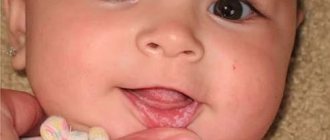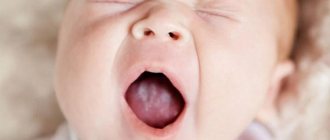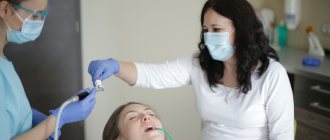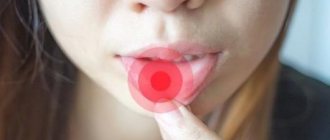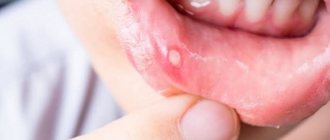07/05/2021 Reading time: 3.5 min 8095 0
Thrush in children is an infectious disease. The causative agent is a fungus of the genus Candida. Therefore, it has the medical name “candidiasis”. Not only the oral mucosa can be affected, but also the skin and membranes of internal organs.
Yeast-like fungi are natural inhabitants of our body. There are many reasons for activating their growth:
- early childhood
- imbalance of microorganisms
- nutritional pattern
- taking antibiotics
- long-term inhaled hormone therapy
What does thrush look like in a child?
Any part of the oropharynx can be affected: tongue, lips, corners of the mouth, gums, mucous membranes of the cheeks, palate, pharynx, tonsils. White grains (spot coating) appear, reminiscent of curdled milk, or a film (solid coating) of a cheesy appearance. These elements are easily removed by scraping with a spatula, revealing a bright red base, sometimes with a bleeding surface. As a rule, the course of the infection is painless and has only local manifestations. General health is not affected.
Symptoms of thrush in a newborn baby
If the plaque is accompanied by the following symptoms, you need to sound the alarm:
- the baby refuses to take the breast, becomes capricious, spits out the pacifier;
- increased salivation;
- drowsiness, loss of appetite;
- swelling of the oral mucosa;
- the formation of shallow painful ulcers under a layer of plaque;
- the plaque itself is removed with a finger;
- whitish discharge has a sour odor;
- there is redness and/or swelling under the plaque;
- plaque spots increase;
- the appearance of cheesy plaques on top of the plaque;
- body temperature constantly remains around 37.5 degrees.
How to treat thrush in a child?
The disease is treated at home. Local medications are used and only as prescribed by a doctor: pediatrician or dentist! Special antifungal agents are used in the form of solutions, sprays, gels, and drops. For maximum effectiveness of therapy, the drug must remain in the oral cavity (on the mucous membrane) for as long as possible. Therefore, the main way to use them is by rinsing or lubricating.
Treatment is long, up to 2-3 weeks.
It is important!
Often thrush in the mouth of infants is associated with candidiasis of the skin of the nipples and areola in the mother. In this case, the woman experiences redness, irritation, and a burning sensation on her chest. In this case, treatment should be comprehensive, for mother and baby.
What to do if your child is not eating well due to oral thrush
Thrush in a child's mouth does not always cause pain and tears. And small white spots on the mucous membrane are easy to miss. Can thrush go away on its own or will it develop into something more serious, how to feed and treat a child with thrush, says allergist-immunologist Tatyana Nikolaevna Dzyaduk.
— Tatyana Nikolaevna, what is candidiasis in a child’s mouth?
— Candidiasis in an infant is a fungal disease of the oral cavity caused by yeast-like fungi of the genus Candida (candida). Of all age groups of children, it occurs most often in infants.
— How is thrush transmitted from mother to child?
— Candida fungi enter the baby’s body when passing through the birth canal, from the nipple of the mammary gland, or from the hands of the mother and staff. True, several cases of a child becoming infected with thrush in the womb have been described due to a violation of the integrity of the membranes. Unfortunately, the intrauterine process leads to stillbirth or miscarriage.
Candida in single quantities is a normal resident of the microflora of the skin and mucous membranes, including the oral mucosa. But when actively multiplying, it causes a disease, which in newborns and infants up to one year is due to the immaturity of the immune system.
— Why does candidiasis more often affect the oral mucosa in children?
— Candida fungi attach well to the epithelium of the oral and vaginal mucosa, which is why candidiasis occurs more often on these organs. The most common fungal infections in young children are oral candidiasis and skin candidiasis in the diaper area and skin folds (diaper rash).
— How is thrush in children related to intestinal infections and acute respiratory infections?
— You can talk about oral thrush after taking antibiotics - this is a risk factor for the disease, but not a necessary condition.
| Dysbacteriosis (changed ratio of bacteria and fungi on the skin and mucous membranes) will lead to thrush if you give your child antibiotics: they will only kill bacteria. Space will be freed up for mushrooms, and they will begin to reproduce more actively. | Regurgitation itself does not in any way affect the presence or absence of thrush. But if the cause of regurgitation is gastroesophageal reflux disease, then its treatment can lead to candidiasis esophagitis - this is a lesion of the esophagus, and not the oral cavity. | Intestinal infections and acute respiratory diseases do not affect the development of oral thrush unless treated with antibiotics. |
— Can formula or breast milk cause oral thrush in a newborn?
— According to statistics, formula-fed children suffer from thrush somewhat more often than breastfed children. This may be due to the fact that breast milk contains substances that inhibit the growth of fungus.
The fungus can enter the baby's body from the mother's breast. Therefore, laboratory detection of fungal cells in breast milk or culture of breast milk is pointless; this will not affect the treatment tactics or the outcome of the disease. But the mother needs to be checked for candidiasis of the nipples during breastfeeding and, if necessary, undergo external treatment, since the presence of candidiasis of the skin of the nipple increases the risk of oral candidiasis in the child.
Child nutrition
Simple carbohydrates are the main nutrient medium for fungal growth. Therefore, sweets, sugar, cookies, etc. must be excluded from the patient’s diet. Breastfeeding certainly continues.
If the child is bottle-fed or mixed-fed, then preference should be given to formulas containing probiotic microorganisms, which have the largest evidence base for their effectiveness. These are LGG and BB-12 from Chr. Hansen. It has been proven that LGG and BB-12 inhibit the growth of opportunistic microorganisms and fungi, protect against the development of caries and infections, and effectively prevent atopic eczema. Nutrilak Premium Comfort is enriched with LGG probiotic.
One of the causes of concern for a child is thrush (candidomycosis stomatitis) and how to deal with it!!!
I already posted this post once, about two months ago, but maybe not everyone read it, it just didn’t catch the eye of someone, so I decided to duplicate it, because I think it’s relevant because the kids are growing up, especially since they’ve already contacted me more than once in a private message , about how we treated, so I’m describing everything in detail!!!
So:
A lot has already been written on this forum about the causes of anxiety and whims of our little angels (colic, gas, weather, teeth, etc.), but there is another possible and often common cause - thrush (candidomycosis stomatitis).
We encountered this misfortune when the baby was only a month old, he became restless during breastfeeding (he refused to breastfeed), then I suggested that his mother look into his mouth and when examining the oral cavity, we found several white spots on the roof of the mouth and tongue!!! the cause of the infection was apparently during the passage of the baby through the birth canal (at that time he had not yet put anything in his mouth)!!! We removed the symptoms and calmed the baby, at an early stage quite quickly, literally in 2-3 days using a solution of Candida 3 -4 times a day, although for complete cure and prevention we lubricated the baby’s mouth and mother’s nipples with a solution for a week, the mother additionally treated the nipples with a soda solution (a teaspoon per glass of water) before treating candida!!! The child’s mouth was not treated with soda, it was calculated that he was still too small, we were afraid!!! Now that our babies are growing up, they put everything in their mouths, spit up profusely, and soon they will start cutting their teeth, no one is safe from this misfortune (God forbid, of course), so I decided post more detailed information for those interested, so that mothers are fully armed and know how to deal with this at an early stage, without even dragging the child to clinics one more time, without catching additional infections there, and without resorting to the help of doctors (which many of you like I realized, reading the forum, they are reluctant to contact)!!!
Manifestation of thrush
The baby develops a white coating - spots or “plaques” on the mucous membranes of the mouth: on the tongue, palate, gums, and the inside of the cheeks, around which a slight inflammation often forms. When removing the plaque, redness will appear underneath (unlike the usual milky coating on the tongue).
The child may be restless, capricious, abandon the breast during feeding or refuse the breast (bottle) altogether, since sucking may cause him pain.
After some time, small spots grow to form large light films or a curd-like coating. Causes of thrush
Thrush in the mouth It is possible for a newborn to become infected with thrush from the mother when he passes through the birth canal if the mother had candidiasis during pregnancy. Babies who were born premature or with weakened immune systems are also predisposed to the appearance of thrush. Babies who have been prescribed antibiotic treatment or who often regurgitate, since the fungus lives in an acidic environment that forms in the baby’s mouth for some time after regurgitation. And also during teething, when the immune system is slightly weakened.
In most cases, the cause of thrush in the mouth is insufficient hygiene care. Infection with the fungus can occur through the mother's nipples, spoons and breast nipples (candidiasis of the skin on the mammary glands in the mother is one of the most common causes of thrush in children), as well as through objects that the baby puts into the mouth.
Thrush in infants is not usually associated with other diseases.
For children in the first 6 months of life, treatment and hygiene are indicated. If the baby is already more than 6 months old and basic hygiene rules are observed, but the treatment does not give a positive effect (or gives a short-term effect), it is necessary to conduct a more detailed examination of the child’s entire body, as this may be a symptom of a more serious illness or a weakened immune system. Treatment and oral hygiene
The danger of thrush is that it makes the mucous membrane easily vulnerable and thereby opens the gates of infection. If thrush is not treated, then in its advanced state it spreads to the entire oral cavity. To treat thrush, various topical preparations (solutions, creams) that contain antifungal components are used. For example, nystatin drops or Candide solution are used (a few drops of Candide solution are applied to a cotton swab or gauze and wiped the child’s oral mucosa 2-3 times a day).
It is recommended to moisten the oral mucosa with a solution of baking soda (1 teaspoon of soda for 1 glass of boiled water at room temperature). To do this, you need to press your thumb on the child’s chin so that he opens his mouth, and treat the entire oral cavity with a swab dipped in a soda solution. Repeat this procedure every 2-3 hours. You can also dip the pacifier in a soda solution and give it to the baby after feeding.
For children six months and older, a single use of Diflucan is possible, but the possibility of using this drug and the dosage must be agreed with the pediatrician.
Folk remedies recommend a teaspoon of honey, diluted in half with water and heated in a water bath. Wrap your finger in a bandage soaked in this solution and wipe the mouth. However, it must be remembered that honey is a strong allergen.
If the baby is breastfed and has signs of thrush, then the mother is also prescribed antifungal treatment, since the infection can easily pass between the mother and the infant. And if treatment is not carried out, re-infection is possible in one to two weeks.
I won’t post pictures (what it might look like) here, anyone interested will find them on the Internet!!!
GOOD HEALTH TO ALL MOMS AND YOUR ANGELS!!!
